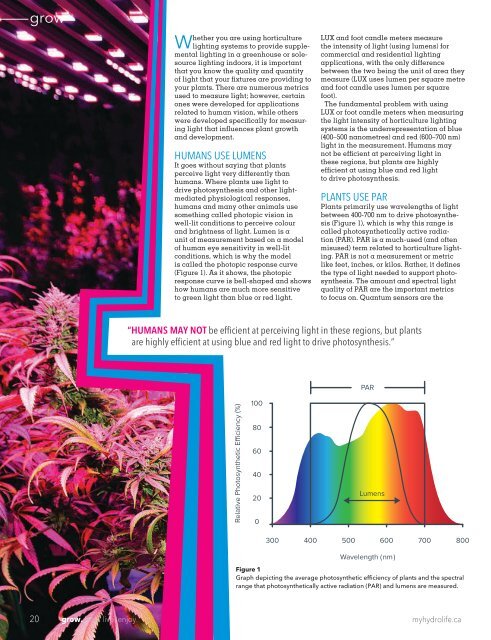Hydrolife Magazine April/May 2017 (Canada Edition)
To know where you’re going, you have to know where you’ve been. The adage rings true for the modern cannabis industry, which is why this issue of Hydrolife takes a look back at the roots of marijuana and how the plant has traveled through history in North America (History of Cannabis Part II).
To know where you’re going, you have to know where you’ve been. The adage rings true for the modern cannabis industry, which is why this issue of Hydrolife takes a look back at the roots of marijuana and how the plant has traveled through history in North America (History of Cannabis Part II).
You also want an ePaper? Increase the reach of your titles
YUMPU automatically turns print PDFs into web optimized ePapers that Google loves.
grow<br />
Whether you are using horticulture<br />
lighting systems to provide supplemental<br />
lighting in a greenhouse or solesource<br />
lighting indoors, it is important<br />
that you know the quality and quantity<br />
of light that your fixtures are providing to<br />
your plants. There are numerous metrics<br />
used to measure light; however, certain<br />
ones were developed for applications<br />
related to human vision, while others<br />
were developed specifically for measuring<br />
light that influences plant growth<br />
and development.<br />
HUMANS USE LUMENS<br />
It goes without saying that plants<br />
perceive light very differently than<br />
humans. Where plants use light to<br />
drive photosynthesis and other lightmediated<br />
physiological responses,<br />
humans and many other animals use<br />
something called photopic vision in<br />
well-lit conditions to perceive colour<br />
and brightness of light. Lumen is a<br />
unit of measurement based on a model<br />
of human eye sensitivity in well-lit<br />
conditions, which is why the model<br />
is called the photopic response curve<br />
(Figure 1). As it shows, the photopic<br />
response curve is bell-shaped and shows<br />
how humans are much more sensitive<br />
to green light than blue or red light.<br />
LUX and foot candle meters measure<br />
the intensity of light (using lumens) for<br />
commercial and residential lighting<br />
applications, with the only difference<br />
between the two being the unit of area they<br />
measure (LUX uses lumen per square metre<br />
and foot candle uses lumen per square<br />
foot).<br />
The fundamental problem with using<br />
LUX or foot candle meters when measuring<br />
the light intensity of horticulture lighting<br />
systems is the underrepresentation of blue<br />
(400–500 nanometres) and red (600–700 nm)<br />
light in the measurement. Humans may<br />
not be efficient at perceiving light in<br />
these regions, but plants are highly<br />
efficient at using blue and red light<br />
to drive photosynthesis.<br />
PLANTS USE PAR<br />
Plants primarily use wavelengths of light<br />
between 400-700 nm to drive photosynthesis<br />
(Figure 1), which is why this range is<br />
called photosynthetically active radiation<br />
(PAR). PAR is a much-used (and often<br />
misused) term related to horticulture lighting.<br />
PAR is not a measurement or metric<br />
like feet, inches, or kilos. Rather, it defines<br />
the type of light needed to support photosynthesis.<br />
The amount and spectral light<br />
quality of PAR are the important metrics<br />
to focus on. Quantum sensors are the<br />
“HUMANS MAY NOT be efficient at perceiving light in these regions, but plants<br />
are highly efficient at using blue and red light to drive photosynthesis.”<br />
PAR<br />
Relative Photosynthetic Efficiency (%)<br />
100<br />
80<br />
60<br />
40<br />
20<br />
0<br />
Lumens<br />
300 400 500 600 700 800<br />
Wavelength (nm)<br />
Figure 1<br />
Graph depicting the average photosynthetic efficiency of plants and the spectral<br />
range that photosynthetically active radiation (PAR) and lumens are measured.<br />
20 grow. heal. live. enjoy.<br />
myhydrolife.ca




![Hydrolife Magazine December 2017/January 2018 [CANADIAN EDITION]](https://img.yumpu.com/59790088/1/190x247/hydrolife-magazine-december-2017-january-2018-canadian-edition.jpg?quality=85)
![Hydrolife Magazine December 2017/January 2018 [USA EDITION]](https://img.yumpu.com/59790042/1/190x247/hydrolife-magazine-december-2017-january-2018-usa-edition.jpg?quality=85)
![Hydrolife Magazine October/November 2017 [Canada Edition]](https://img.yumpu.com/59493562/1/190x247/hydrolife-magazine-october-november-2017-canada-edition.jpg?quality=85)
![Hydrolife Magazine October/November 2017 [USA Edition]](https://img.yumpu.com/59493548/1/190x247/hydrolife-magazine-october-november-2017-usa-edition.jpg?quality=85)
![Hydrolife Magazine August/September 2017 [USA Edition]](https://img.yumpu.com/59236656/1/190x247/hydrolife-magazine-august-september-2017-usa-edition.jpg?quality=85)








